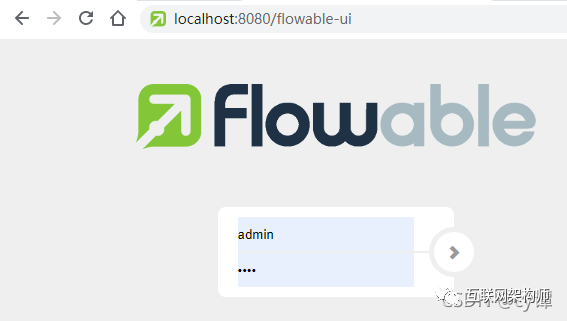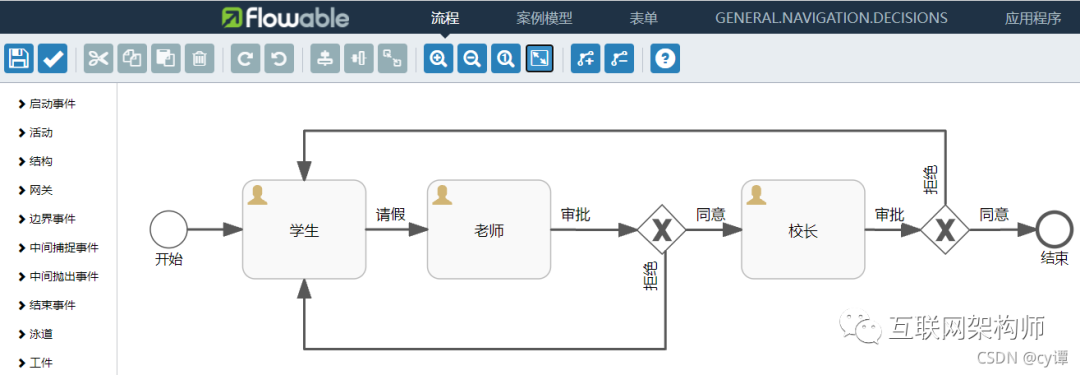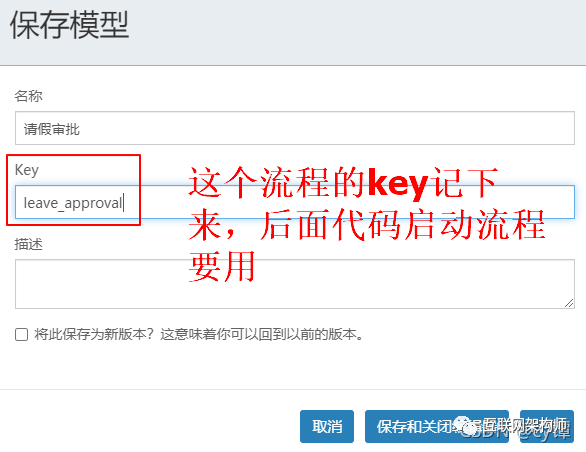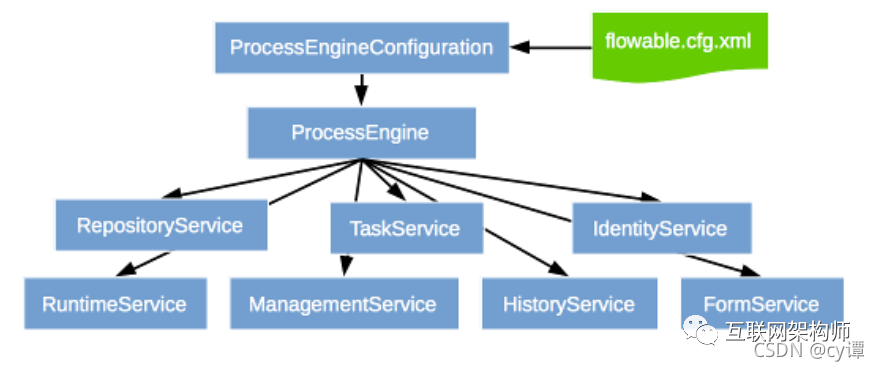背景
使用flowable自带的flowable-ui制作流程图 使用springboot开发流程使用的接口完成流程的业务功能
flowable-ui部署运行
flowable-6.6.0 运行 官方demo
https://flowable.com/open-source/docs/bpmn/ch14-Applications/
1、从官网下载flowable-6.6.0 : https://github.com/flowable/flowable-engine/releases/download/flowable-6.6.0/flowable-6.6.0.zip
2、将压缩包中的 flowable-6.6.0\wars\flowable-ui.war 丢到Tomcat中跑起来
3、打开http://localhost:8080/flowable-ui 用账户:admin/test 登录

4、进入APP.MODELER创建流程,之后可以导出流程到项目中使用,或者配置
apache-tomcat-9.0.37\webapps\flowable-ui\WEB-INF\classes\flowable-default.properties连接本地数据库

绘制流程图

根据业务需要在 flowable-ui>APP.MODELER里面绘制流程图,示例如上图。先解释一些概念。
事件(event)通常用于为流程生命周期中发生的事情建模,图里是【开始、结束】两个圈。
顺序流(sequence flow)是流程中两个元素间的连接器。图里是【箭头线段】。
网关(gateway)用于控制执行的流向。图里是【菱形(中间有X)】
用户任务(user task)用于对需要人工执行的任务进行建模。图里是【矩形】。
简单的工作流大概就这些元素(还有很多这里就不扩展了)。下面描述一下工作流是如何流动的。另外,Spring 系列面试题和答案全部整理好了,微信搜索互联网架构师,在后台发送:面试,可以在线阅读。
绘图细节:
1、保留流程模型

2、顺序流可以设置流条件来限制流动,比如上面的网关出口就设置了条件

3、任务需要分配任务的执行用户,可以分配到候选组,也可以直接分配到候选人

最后导出工作流文件

文件内容
<?xml version="1.0" encoding="UTF-8"?>
<definitions xmlns="http://www.omg.org/spec/BPMN/20100524/MODEL" xmlns:xsi="http://www.w3.org/2001/XMLSchema-insmtece" xmlns:xsd="http://www.w3.org/2001/XMLSchema" xmlns:flowable="http://flowable.org/bpmn" xmlns:bpmndi="http://www.omg.org/spec/BPMN/20100524/DI" xmlns:omgdc="http://www.omg.org/spec/DD/20100524/DC" xmlns:omgdi="http://www.omg.org/spec/DD/20100524/DI" typeLanguage="http://www.w3.org/2001/XMLSchema" expressionLanguage="http://www.w3.org/1999/XPath" targetNamespace="http://www.flowable.org/processdef">
<process id="leave_approval" name="请假审批" isExecutable="true">
<startEvent id="start" name="开始" flowable:initiator="startuser" flowable:formFieldValidation="true"></startEvent>
<userTask id="stu_task" name="学生" flowable:candidateGroups="stu_group" flowable:formFieldValidation="true"></userTask>
<sequenceFlow id="flow1" sourceRef="start" targetRef="stu_task"></sequenceFlow>
<userTask id="te_task" name="老师" flowable:candidateGroups="te_group" flowable:formFieldValidation="true"></userTask>
<exclusiveGateway id="getway1" name="网关1"></exclusiveGateway>
<userTask id="mte_task" name="校长" flowable:candidateGroups="mte_group" flowable:formFieldValidation="true"></userTask>
<exclusiveGateway id="getway2" name="网关2"></exclusiveGateway>
<endEvent id="end" name="结束"></endEvent>
<sequenceFlow id="flow1" name="请假" sourceRef="stu_task" targetRef="te_task" skipExpression="${command=='agree'}"></sequenceFlow>
<sequenceFlow id="flow3_1" name="同意" sourceRef="getway1" targetRef="mte_task">
<conditionExpression xsi:type="tFormalExpression"><![CDATA[${command=='agree'}]]></conditionExpression>
</sequenceFlow>
<sequenceFlow id="flow2" name="审批" sourceRef="te_task" targetRef="getway1"></sequenceFlow>
<sequenceFlow id="flow3_2" name="拒绝" sourceRef="getway1" targetRef="stu_task">
<conditionExpression xsi:type="tFormalExpression"><![CDATA[${command=='refuse'}]]></conditionExpression>
</sequenceFlow>
<sequenceFlow id="flow4" name="审批" sourceRef="mte_task" targetRef="getway2"></sequenceFlow>
<sequenceFlow id="flow4_1" name="同意" sourceRef="getway2" targetRef="end" skipExpression="${command=='free'}">
<conditionExpression xsi:type="tFormalExpression"><![CDATA[${command=='agree'}]]></conditionExpression>
</sequenceFlow>
<sequenceFlow id="flow4_2" name="拒绝" sourceRef="getway2" targetRef="stu_task">
<conditionExpression xsi:type="tFormalExpression"><![CDATA[${command=='refuse'}]]></conditionExpression>
</sequenceFlow>
</process>
<bpmndi:BPMNDiagram id="BPMNDiagram_leave_approval">
这里先省略
</bpmndi:BPMNDiagram>
</definitions>4、bpmn文件导入

后台项目搭建
后台项目基于jdk8,使用springboot框架
spring 版本
<parent>
<groupId>org.springframework.boot</groupId>
<artifactId>spring-boot-starter-parent</artifactId>
<version>2.3.0.RELEASE</version>
<relativePath/> <!-- lookup parent from repository -->
</parent><dependency>
<groupId>org.flowable</groupId>
<artifactId>flowable-spring-boot-starter</artifactId>
<version>6.6.0</version>
</dependency>
<dependency>
<groupId>mysql</groupId>
<artifactId>mysql-connector-java</artifactId>
<version>5.1.45</version>
</dependency>项目配置application.yml
spring:
datasource:
url: jdbc:mysql://localhost:3306/flowable?useSSL=false&characterEncoding=UTF-8&serverTimezone=GMT%2B8
driver-class-name: com.mysql.jdbc.Driver
username: root
password: 123456数据库
1、Flowable的所有数据库表都以ACT_开头。第二部分是说明表用途的两字符标示符。服务API的命名也大略符合这个规则。
2、ACT_RE_: 'RE’代表repository。带有这个前缀的表包含“静态”信息,例如流程定义与流程资源(图片、规则等)。
4、ACT_HI_: 'HI’代表history。这些表存储历史数据,例如已完成的流程实例、变量、任务等。
2)历史表(8个,HistoryService接口操作的表)
3)用户相关表(4个,IdentityService接口操作的表)
4)流程定义、流程模板相关表(3个,RepositoryService接口操作的表)
act_re_procdef:流程定义信息表,存储流程定义相关描述信息,但其真正内容存储在act_ge_bytearray表中,以字节形式存储;
act_re_model:流程模板信息表,存储流程模板相关描述信息,但其真正内容存储在act_ge_bytearray表中,以字节形式存储;
5)流程运行时表(6个,RuntimeService接口操作的表)
act_ru_task:运行时流程任务节点表,存储运行中流程的任务节点信息,重要,常用于查询人员或部门的待办任务时使用;
act_ru_execution:运行时流程执行实例表,记录运行中流程运行的各个分支信息(当没有子流程时,其数据与act_ru_task表数据是一一对应的);
流程引擎API与服务
引擎API是与Flowable交互的最常用手段。总入口点是ProcessEngine。

1、RepositoryService很可能是使用Flowable引擎要用的第一个服务。这个服务提供了管理与控制部署(deployments)与流程定义(process definitions)的操作。管理静态信息,
2、RuntimeService用于启动流程定义的新流程实例。
3、IdentityService很简单。它用于管理(创建,更新,删除,查询……)组与用户。
4、FormService是可选服务。也就是说Flowable没有它也能很好地运行,而不必牺牲任何功能。
5、HistoryService暴露Flowable引擎收集的所有历史数据。要提供查询历史数据的能力。
6、ManagementService通常在用Flowable编写用户应用时不需要使用。它可以读取数据库表与表原始数据的信息,也提供了对作业(job)的查询与管理操作。
7、DynamicBpmnService可用于修改流程定义中的部分内容,而不需要重新部署它。例如可以修改流程定义中一个用户任务的办理人设置,或者修改一个服务任务中的类名。
接下来使用之前的请假流程图,上代码
import lombok.extern.slf4j.Slf4j;
import org.flowable.engine.HistoryService;
import org.flowable.engine.RepositoryService;
import org.flowable.engine.RuntimeService;
import org.flowable.engine.history.HistoricProcessInstance;
import org.flowable.engine.repository.Deployment;
import org.flowable.engine.repository.ProcessDefinition;
import org.flowable.engine.runtime.Execution;
import org.flowable.engine.runtime.ProcessInstance;
import org.flowable.idm.api.Group;
import org.flowable.idm.api.User;
import org.flowable.task.api.Task;
import org.flowable.task.api.history.HistoricTaskInstance;
import org.springframework.beans.factory.annotation.Autowired;
import java.io.File;
import java.io.FileInputStream;
import java.io.FileNotFoundException;
import java.util.HashMap;
import java.util.List;
import java.util.Map;
import java.util.zip.ZipInputStream;
/**
* TestFlowable
*
* @Author
* @Date: 2021/10/17 23:35
* @Version 1.0
*/
@Slf4j
public class TestFlowable {
@Autowired
private RepositoryService repositoryService;
@Autowired
private RuntimeService runtimeService;
@Autowired
private HistoryService historyService;
@Autowired
private org.flowable.engine.TaskService taskService;
@Autowired
private org.flowable.engine.IdentityService identityService;
public void createDeploymentZip() {
/*
* @Date: 2021/10/17 23:38
* Step 1: 部署xml(压缩到zip形式,直接xml需要配置相对路径,麻烦,暂不用)
*/
try {
File zipTemp = new File("f:/leave_approval.bpmn20.zip");
ZipInputStream zipInputStream = new ZipInputStream(new FileInputStream(zipTemp));
Deployment deployment = repositoryService
.createDeployment()
.addZipInputStream(zipInputStream)
.deploy();
log.info("部署成功:{}", deployment.getId());
} catch (FileNotFoundException e) {
e.printStackTrace();
}
/*
* @Date: 2021/10/17 23:40
* Step 2: 查询部署的流程定义
*/
List<ProcessDefinition> list = repositoryService.createProcessDefinitionQuery().processDefinitionKey("leave_approval").list();
List<ProcessDefinition> pages = repositoryService.createProcessDefinitionQuery().processDefinitionKey("leave_approval").listPage(1, 30);
/*
* @Date: 2021/10/17 23:40
* Step 3: 启动流程,创建实例
*/
String processDefinitionKey = "leave_approval";//流程定义的key,对应请假的流程图
String businessKey = "schoolleave";//业务代码,根据自己的业务用
Map<String, Object> variablesDefinition = new HashMap<>();//流程变量,可以自定义扩充
ProcessInstance processInstance = runtimeService.startProcessInstanceByKey(processDefinitionKey, businessKey, variablesDefinition);
log.info("启动成功:{}", processInstance.getId());
/*
* @Date: 2021/10/17 23:40
* Step 4: 查询指定流程所有启动的实例列表
* 列表,或 分页 删除
*/
List<Execution> executions = runtimeService.createExecutionQuery().processDefinitionKey("leave_approval").list();
List<Execution> executionPages = runtimeService.createExecutionQuery().processDefinitionKey("leave_approval").listPage(1, 30);
// runtimeService.deleteProcessInstance(processInstanceId, deleteReason); //删除实例
/*
* @Date: 2021/10/17 23:40
* Step 5: 学生查询可以操作的任务,并完成任务
*/
String candidateGroup = "stu_group"; //候选组 xml文件里面的 flowable:candidateGroups="stu_group"
List<Task> taskList = taskService.createTaskQuery().taskCandidateGroup(candidateGroup).orderByTaskCreateTime().desc().list();
for (Task task : taskList) {
// 申领任务
taskService.claim(task.getId(), "my");
// 完成
taskService.complete(task.getId());
}
/*
* @Date: 2021/10/17 23:40
* Step 6: 老师查询可以操作的任务,并完成任务
*/
String candidateGroupTe = "te_group"; //候选组 xml文件里面的 flowable:candidateGroups="te_group"
List<Task> taskListTe = taskService.createTaskQuery().taskCandidateGroup(candidateGroupTe).orderByTaskCreateTime().desc().list();
for (Task task : taskListTe) {
// 申领任务
taskService.claim(task.getId(), "myte");
// 完成
Map<String, Object> variables = new HashMap<>();
variables.put("command","agree"); //携带变量,用于网关流程的条件判定,这里的条件是同意
taskService.complete(task.getId(), variables);
}
/*
* @Date: 2021/10/18 0:17
* Step 7: 历史查询,因为一旦流程执行完毕,活动的数据都会被清空,上面查询的接口都查不到数据,但是提供历史查询接口
*/
// 历史流程实例
List<HistoricProcessInstance> historicProcessList = historyService.createHistoricProcessInstanceQuery().processDefinitionKey("leave_approval").list();
// 历史任务
List<HistoricTaskInstance> historicTaskList = historyService.createHistoricTaskInstanceQuery().processDefinitionKey("leave_approval").list();
// 实例历史变量 , 任务历史变量
// historyService.createHistoricVariableInstanceQuery().processInstanceId(processInstanceId);
// historyService.createHistoricVariableInstanceQuery().taskId(taskId);
// *****************************************************分隔符********************************************************************
// *****************************************************分隔符********************************************************************
// 可能还需要的API
// 移动任务,人为跳转任务
// runtimeService.createChangeActivityStateBuilder().processInstanceId(processInstanceId)
// .moveActivityIdTo(currentActivityTaskId, newActivityTaskId).changeState();
// 如果在数据库配置了分组和用户,还会用到
List<User> users = identityService.createUserQuery().list(); //用户查询,用户id对应xml 里面配置的用户
List<Group> groups = identityService.createGroupQuery().list(); //分组查询,分组id对应xml 里面配置的分组 如 stu_group,te_group 在表里是id的值
// 另外,每个查询后面都可以拼条件,内置恁多查询,包括模糊查询,大小比较都有
}
}参考资料
【1】分享牛Flowable文档汉化:https://github.com/qiudaoke/flowable-userguide
【2】猫七姑娘 flowable-6.6.0 运行官方 demo
【3】华格瑞沙 https://www.cnblogs.com/yangjiming/p/10938515.html
本文链接:https://blog.csdn.net/zhan107876/article/details/120815560
END




















 586
586











 被折叠的 条评论
为什么被折叠?
被折叠的 条评论
为什么被折叠?








